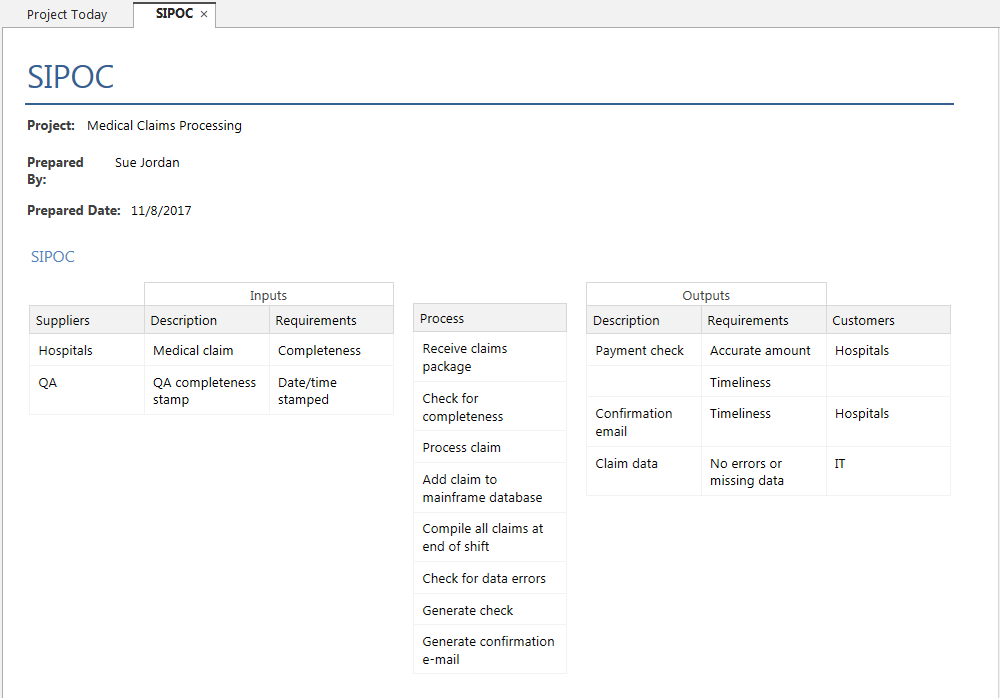Choosing an appropriate Six Sigma project is challenging, and one of the biggest areas of risk involves the size and focus of the project. A simple form referred to as a SIPOC can be a big help when it comes to selecting a project that has a high likelihood of success.
I explained in some detail what a SIPOC is in an earlier post, but here's the bottom-line version. The SIPOC acronym stands for Suppliers - Inputs - Process - Outputs - Customers. A good SIPOC form makes it easy to capture basic information about a process, who and what plays a role in it, the steps involved, and who is affected by the outputs or outcomes.
The SIPOC form has three sections:
- On the left, you have process Inputs and Suppliers of those inputs
- In the middle, you have the Process
- On the right, you have the process Outputs and the Customers of the outputs
How Does a SIPOC Help Me Choose a Project?
The completed SIPOC form gives you a high-level process map. You can use it to get a clearer understanding of the scope of a process. A SIPOC helps answer questions about where a process starts and ends, its major steps, primary inputs and outputs as well as the key internal and external customers and suppliers.
When it comes to defining Six Sigma projects, a SIPOC helps by isolating areas that need improvement. A SIPOC also helps identify whether proposed objectives would require changes that are too large or too numerous to be achieved in a single project.
A Completed SIPOC Example
Below is a SIPOC form that has been filled out, to give you an idea of the kind of information you want to capture with this tool.

This form is for a project that aimed to reduce the amount of time it took to cycle health insurance claims. Let's take a closer look at the different parts of the form.
Process

Although it doesn't come first in the SIPOC acronym, it's a good idea to begin by filling out the steps in your Process. List the major steps -- most importantly, the start and end points -- so the scope of the process is clear. You don't have to list every step or activity. In the example, the project team listed the key steps involved, including those performed by computers after each shift.
Outputs and Customers

Let's look at the outputs and customers section next. Adding both a Description and Requirements column when you list the outputs is particularly helpful. The claims process has three outputs (check, e-mail, and data) and each has requirements that need to be met.
In Customers, the team has listed the consumers of the process output. Note that customers can be internal (IT) or external (hospitals) to an organization. You may not always have a customer for every output.
Inputs and Suppliers

As they did with the Outputs, the team has entered both a Description and Requirements for each listed input. The Suppliers of the inputs are handled the same as Consumers of the outputs. Suppliers can be matched with input descriptions or requirements, and you might not need to list a supplier for every input.
Creating a SIPOC
The information the team gathered in this SIPOC will help the team answer questions about where the claims cycle starts and ends, its critical steps, primary inputs and outputs as well as the key internal and external customers and suppliers. With this information, they'll be able to define a well-scoped project that can achieve solid improvements -- and avoid initiating a project that's just too big to succeed.
SIPOC isn't a high-tech tool; you could just use pencil and paper to create one! However, you can also use various software tools, including the SIPOC form included in Minitab Engage, our process improvement software. The Engage SIPOC shares the data you enter with application's other tools, so you don't have to re-enter the same information in separate tools as you go through your project, which is a nice feature.


